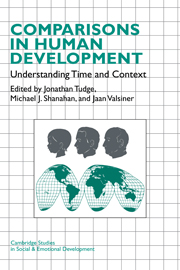Book contents
- Frontmatter
- Contents
- List of Contributors
- Comparisons in Human Development: To Begin a Conversation
- Part One Metatheoretical Approaches to Developmental Comparisons
- Part Two Paradigmatic Statements
- 4 Nested Comparisons in the Study of Historical Change and Individual Adaptation
- 5 The Value of Comparisons in Developmental Psychology
- 6 Implications from Developmental Cross-cultural Research for the Study of Acculturation in Western Civilizations
- Part Three Comparisons at the Level of Data
- Part Four Commentaries
- Author Index
- Subject Index
4 - Nested Comparisons in the Study of Historical Change and Individual Adaptation
Published online by Cambridge University Press: 04 May 2010
- Frontmatter
- Contents
- List of Contributors
- Comparisons in Human Development: To Begin a Conversation
- Part One Metatheoretical Approaches to Developmental Comparisons
- Part Two Paradigmatic Statements
- 4 Nested Comparisons in the Study of Historical Change and Individual Adaptation
- 5 The Value of Comparisons in Developmental Psychology
- 6 Implications from Developmental Cross-cultural Research for the Study of Acculturation in Western Civilizations
- Part Three Comparisons at the Level of Data
- Part Four Commentaries
- Author Index
- Subject Index
Summary
Sociological studies of human development take a variety of forms, including sequences of comparisons that establish links between the changing social environment and individual adaptation. This chapter focuses on mechanisms linking broader societal patterns to individuals, by beginning with groups defined by social change and proceeding with fully contained subgroups. We specify the conceptual basis for nested comparisons; such an approach is best understood in conjunction with quasi–experimental strategies that capitalize on Bronfenbrenner's (1979) “transforming experiment.” We next consider the utility of nested comparisons in formulating research questions within the life course framework. At this point, we extend the strategy of nested comparisons to facilitate the integration of quantitative and qualitative analyses. This integration provides a strategy for linking patterns of adaptation among groups with the diversity of adjustive processes among individuals. Our approach is illustrated with a detailed case study that connects service in World War II with postwar health patterns.
In thematic terms, the connection between social change and the individual represents a foundational issue in the emergence of sociology (Mazlish, 1991) and can be found in many of the early efforts of the Chicago school of sociology (Bulmer, 1984; Faris, 1967). Particularly noteworthy is Thomas and Znaniecki's (1918–1920) exhaustive The Polish Peasant in Europe and America, a study of social change in the lives of Polish immigrants to the United States.
- Type
- Chapter
- Information
- Comparisons in Human DevelopmentUnderstanding Time and Context, pp. 109 - 136Publisher: Cambridge University PressPrint publication year: 1996



